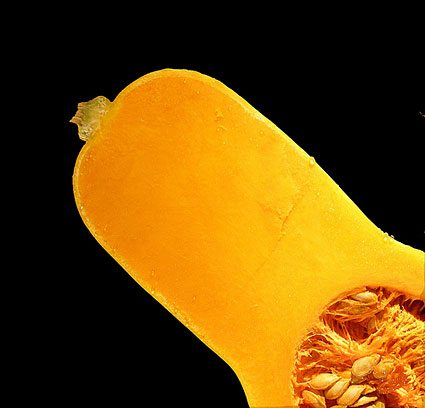 Butternut squash soup.
Butternut squash soup.
Lots of people claim they don’t have time to cook fresh meals “from scratch.” In Tom’s Kitchen, I share some of the quick and easy things I get up to in … well, my kitchen.
 Seed saving: The seeds and fibers of the squash can make a great little stock with which to purée the flesh.Photo: judywrossA couple of years ago, we had a massive fall harvest at Maverick Farms, including great quantities of butternut squash, leafy greens like kale and collards, and garlic.
Seed saving: The seeds and fibers of the squash can make a great little stock with which to purée the flesh.Photo: judywrossA couple of years ago, we had a massive fall harvest at Maverick Farms, including great quantities of butternut squash, leafy greens like kale and collards, and garlic.
I mean, lots; it was out of control. Out of self-defense as much as anything else, I learned to combine these ingredients — which happen to be some of my favorite foods in the world — into a simple, satisfying take on a classic fall soup. And I’ve been making it ever since.
My tweaks to butternut squash soup are threefold. First, when you hollow out the fat end of the squash halves to prepare them for roasting, you get a fistful of seeds and stringy orange stuff that isn’t good to eat, but has great squashy aroma. At first I’d save the seeds for next year’s planting and compost the rest. But then we had enough saved seeds, and I got tired of composting what seemed like a valuable culinary resource.
So I started throwing it into a little pot, adding water to it, and making squash stock with it while the squash halves roasted. The stock would help moisten the roasted squash for the purée. Do you see? It’s a closed-loop soup — the squash generates the raw material of its own stock. The stock heightens the squashiness of the resulting soup: kind of a squash-squared effect.
The second tweak involves those fist-sized air pockets that you get when you lay the scraped-out squash halves onto a sheet pan to roast. In a technique I think I cribbed from Cook’s Illustrated years ago, I took to placing a few unpeeled garlic cloves in each one to roast along with the squash. When the squash is done, beautifully browned, fragrant nuggets emerge, ready to be puréed into the soup.
The final tweak is about hearty fall greens. Like a corn-industry technician eyeing mountains of excess product, I needed to find novel uses for all the greens we were cranking out. I found that sautéed, chopped, and added to the soup, fall greens contribute textural and visual contrast as well as an earthy flavor to the finished soup.
Here’s how I do it.
Butternut squash soup with sautéed greens
Makes 4 servings.
Mise en place:
1 good-sized butternut squash, carefully halved lengthwise with a sharp knife
6-8 cloves garlic
Olive oil
Sea salt
Pepper grinder
1 bunch fall greens, such as kale or collards, rinsed and patted dry
Mild vinegar, such as red-wine or apple cider
Crushed chile flakes (optional)
Handful of store-bought raw pumpkin seeds, lightly toasted in a dry (oil-less) skillet over medium heat
Preheat oven to 425. Using a spoon, scrape seeds and stringy stuff out of fat end of each squash half. Place it all into a small pot, add water just to cover, and cook on high heat. When the water boils, lower heat and allow to simmer, uncovered, until it’s time to use the stock. (If the water level drops noticeably during the cooking, add a bit more.)
Now splash a little olive oil on each squash half, cut side up, and rub it lightly into the flesh, making sure the whole surface is slicked with oil. Season the oiled sides liberally with salt, pepper, and if desired, chile pepper flakes. Place them cut-side down on a cookie sheet, and slip 2-3 garlic cloves into the cavity of each one, leaving the squash halves flat on the sheet, cut side down. Place in hot oven to roast.
Now to the greens. Crush and peel two cloves of garlic; mince. Add them to a broad, heavy-bottomed skillet with a good splash of olive oil and, if desired, a lashing of chile flakes, and turn heat to low, giving the garlic a stir. Let the garlic heat gently in the oil, stirring occasionally and monitoring it to make sure it doesn’t start to burn. If it does, remove immediately from heat.
Now take the bunch of greens and lay them flat in a pile. Slice out the tough part of the stems, with an authoritative cut to each side. With the leaves still stacked, roll them lengthwise into a long tubular shape, and slice cross-wise into ribbons of about a half-inch. By now your garlic will be fragrant and the pan will be hot. Add the sliced greens and a pinch of salt. Raise heat to medium and stir, letting them sauté a bit. When the greens have been well-coated in garlicky oil, add a little water to the pot and cover, turning heat to low. Cook, stirring occasionally, until greens have reached your ideal state of tenderness. When they’re done, splash with some vinegar and add salt to taste. They should be good enough to eat on their own. Let cool.
Check your squash halves by plunging a fork into the thin side. They are done when the fork enters the flesh without much trouble,
At a certain point, the squash and greens will both be done. Let the squash cool a little, then scoop their flesh into a pot, discarding the skin. Peel the roasted garlic cloves and add them to the pot. Pour the hot squash stock directly into the pot, straining through a sieve. This won’t be enough liquid to moisten the puree; so add a pint or so of liquid (water or other stock) to the pot. Purée with an immersion blender until smooth and velvety. If the purée seems too thick, add more liquid.
Now place the cooled greens on a cutting board and chop them coarsely into bite-sized pieces. Stir them into the soup. Bring soup to desired eating temperature over medium heat and taste for salt.
Serve in soup bowls, garnishing each one (if desired) with a sprinkling of the toasted pumpkin seeds.



